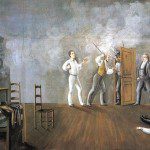In 1960, John F. Kennedy and Richard Nixon famously faced each other in the first televised presidential debates in American history. Nixon appeared sickly and sweaty; Kennedy handsome and strong. Not only did the debates have a major impact on the outcome of the presidential campaign, but they heralded a new era for American media: we wanted to see ourselves represented in the images of our leaders.
More than just a cosmetic satiation, the need to see ourselves reflected in our role models and leaders serves several fundamental human needs in our modern age. Today, even more than in 1960, we are challenged in finding meaningful communities. We are told to be ourselves, express ourselves, and not to care what other people think about us, but at our cores we yearn for tribes where we feel safe and where the boundaries have been drawn for what is and is not acceptable. We celebrate diversity of peoples, races, cultures and genders for the beauty and variety they bring to our earthly experiences, but we also treasure the feeling of identifying with someone just like us. As our culture becomes more and more ethnically and culturally fractured, we each feel the need to find ourselves reflected in public role models. We are no longer accustomed to one kind of person – historically, a white male – representing or speaking for the needs and feelings of each of us individually. In his October 2013 conference talk, Elder Uchtdorf declared, “The diversity of persons and peoples all around the globe is a strength of this Church.” This need for diversity is not merely self-gratifying superficialism; it satisfies a deep spiritual need for our individual worth to be honored in a cacophony of voices.
With more information available than ever before in history, connecting with people who we feel can empathize with our life experiences provides a filter by which we can evaluate information more effectively. We trust them. Bonding with those like us alleviates the feeling of isolation that can come from living such disparate lives, full of choices and pitfalls. While some may scoff at contemporary diversity efforts as tokenism or just filling quotas, there is no turning back on our need to answer the fundamental questions, “Where am I? Where do I fit in? Who is speaking for me?” In a media-driven culture such as our own, where 57% of internet traffic in 2015 will be video consumption and 1 minute of video is estimated to be “worth” 1.8 million words, the answers come from how we see ourselves represented in video and other visual media.
Because of these facts of global, modern life, my eyes filled when I saw the photos and read the biographies of the new members of the Young Women general board. Melissa Inouye spoke eloquently about a need for diverse representation in church settings on this blog several months ago, and I am encouraged that we are institutionally recognizing and responding to the human need to be represented.
Here in the Young Women general board is a model for a global church. Out of nine representatives, four live in Utah, which is still an overrepresentation with only 14% of the Church’s membership living in Utah. However, if we consider New York City representative Janet Nelson as one of five American representatives, then American representation on the board is much closer to the Church’s own domestic/international division. It gets exciting when we look at the remaining four: women from Peru, South Africa, Japan and Brazil are in those ranks.
But I am not only heartened by the locations and the colors of these women’s faces, as beautiful as they are. Did you notice there are two PhDs on the list? A judge? One BYU faculty member? And, if I’m reading the biographies right, two of the women are not married and do not have children. What a gift to our girls to have admirable role models who might not fall within our preached ideal, as many of them won’t either.
At the Mormon Women Project, we repeat an oft-used mantra attributed to Marie Wilson of the White House Project: You can’t be what you can’t see. Latter-day Saint women today live in a world of limitless possibilities and choices, the freedom of which, in some ways, make role models and a guiding hand more important than ever. The examples of other women – from the Mormon Women Project, from the lives of our female spiritual leaders or from other admirable women – offer a template for the spiritual creation of a life path, before we individually go and create those paths physically for ourselves. The Lord described this process of creation in Moses 3:5 when he said, “For I, the Lord God, created all things, of which I have spoken, spiritually, before they were naturally upon the face of the earth.” Role models very literally allow us to see potential paths played out in others’ lives before enacting them in our own. We can create life choices spiritually before creating them “naturally”.
When women do not see themselves reflected in the images that represent us as a people, there is for some women a sense of invisibility and thus unimportance. After a Deseret News article about the possibility of a women praying in general conference for the first time, a reader addressed previous comments that such a change would be meaningless. The commenter said, “The reason [a woman praying in conference] is important is because organizations (like the church) sometimes inadvertently send messages about what they believe through their actions. For example, imagine that half of the church membership was of Asian ancestry and over a period of 150+ years we never asked an Asian person to pray at general conference. Would there be a message there? What would you think if you were of Asian ancestry?… We have to be thoughtful about our actions as a church because sometimes traditions (perhaps false traditions) send wrong messages. Women not praying at General Conference is probably a good example of this.”
I see awareness, appreciation and action on the part of our male and female leaders of the impact of gender and cultural representation on the general level. On a personal note, I feel particularly grateful to see the face of Janet Nelson among the nine. Janet raised four kids in a brownstone in Brooklyn, when Brooklyn wasn’t the hipster haven it is today. She’s lived in New York City for 30 years; I lived there for 23. There are only a handful of Mormons who understand my personal identity as a Mormon New Yorker, and by virtue of our shared experience, she is one of them. While we were in her ward in Brooklyn, it was impossible to miss Janet’s influence which extended until the very night we moved out of the city: It was Janet who gave us sleeping bags and blankets to sleep on after the movers had taken away all our furniture. She is my tribe, my people.
My mind quickly moves from celebrating Janet’s new opportunity to wondering how her influence will be felt by young women around the world. How will these women be used? How will their voices be heard? Increased transparency into the activities and responsibilities of the women’s general boards would help increase my confidence that these truly are role models and not just figureheads. My hope now is that, when these women complete their terms, I will be able to say with confidence that their voices were heard and that they played an active role in lifting and encouraging young women everywhere.











